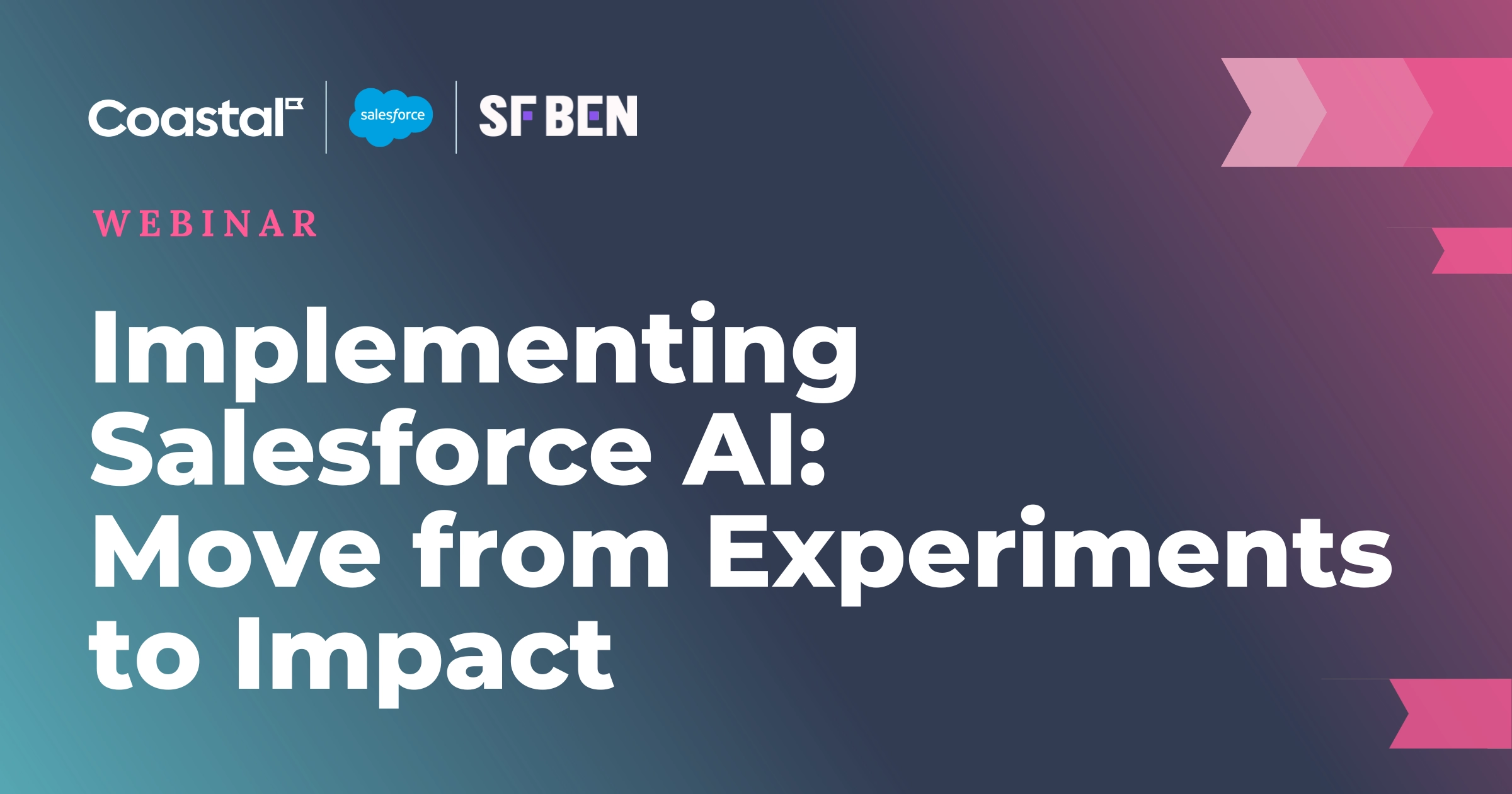Ask a simple question: “What’s driving the churn in Northeast revenue?”
Instead of navigating dashboards and squinting at charts, you get an answer. The causes. The metrics. The context. All surfaced instantly, in language you understand. Within seconds.
This shift isn’t theoretical. It’s already happening in Tableau Next.
Dashboards helped teams align around performance. But as backlogs grow and definitions splinter, they’ve become bottlenecks—slowing decisions and eroding trust.
Salesforce is rebuilding how analytics works, moving from dashboards that visualize the past to systems that interpret questions based on connected, unified data, and bundling product SKUs to make this easier. Tableau Next and Agentforce are part of this shift.
They’re built on the assumption that your data is already connected and contextualized—work that happens in your data platform, not your dashboards. That’s where Data Cloud comes in. It acts as the connective tissue—unifying siloed data, activating business context, and powering the semantic consistency these tools rely on.
These tools assume your data is already aligned and documented. They’re built on clarity. If your data isn’t ready, they won’t meet you halfway.
From Static Charts to Smart Conversations
This evolution changes how people interact with data. Instead of clicking through dashboard tabs, users have conversations with their information.
Here’s how it works: A user asks Agentforce a question in plain language—”Which products are losing market share?” or “Where are we over plan this quarter?” The system parses the question, connects it to your semantic layer, applies the correct metric definitions, and returns both an answer and a supporting visualization.
This saves time and delivers insight when it’s needed most. Analytics becomes part of the workflow instead of a separate destination. A sales manager can ask questions mid-call. A marketing lead can review campaign performance while planning the next launch.
The data responds to the business context—not the other way around.
But conversations break down if the data can’t speak clearly. Agentforce needs structure: shared definitions, labeled fields, and context it can understand.
The Safety Net Is Disappearing
Tableau has always given teams flexibility, especially at the visualization layer. If something didn’t quite match, you could adjust it in the dashboard. Add a filter. Build a calculated field. Patch it without going back to the source.
That’s changing.
Tableau Next removes that flexibility by design. Customizations that once lived in dashboards now need to be defined earlier—in the data itself. If a metric like “profit” isn’t clearly defined at the source, you can’t adjust for it later. The system won’t guess. It won’t patch.
Users ask questions in plain language—”What’s driving churn in the Northeast?”—and expect intelligent responses. But Agentforce relies entirely on connected, labeled data with consistent definitions across teams. Without that foundation, the conversation never starts.
The responsibility shifts upstream. Clarity can’t be retrofitted—it has to be built in from the start.
What’s Changing Under the Hood: The Three Foundation Layers
This shift starts under the surface, not in the dashboard.
The semantic layer ensures every field means the same thing across your entire organization. When someone asks Agentforce about “churn,” the system needs to know exactly what that refers to consistently, across sales, marketing, and finance.
The metrics layer makes calculations reusable and transparent. Once “gross margin” is modeled, it’s applied consistently across every report, dashboard, and Agentforce conversation—no custom rebuilds required.
Logical Views structure context across multiple data sources. They link shared fields across tables, so users can explore and filter data across sources as if they came from the same place.
Success here isn’t just technical—it’s organizational. Without alignment, you’re setting AI up to misfire.
The Composable Models Revolution
This shift raises the bar: define it once, trust it everywhere.
One model. One meaning. Reused across every chart, report, and question.
Instead of rebuilding logic in every dashboard, teams create semantic models that span the entire analytics ecosystem—from Tableau visualizations to Agentforce conversations to embedded workflows.
Let’s say one table holds employee performance data. Another tracks transactions. Both have date fields. Logical Views let those fields work together—unified, without duplication or manual cleanup.
When built on Salesforce Data Cloud, these layers stay connected and dynamic. Your semantic definitions don’t live in one tool—they flow across the entire platform. The same metric works in Tableau Next, Agentforce, and Flow-based automations—no recreating logic in three places. The business logic travels with the data, ensuring consistency and speed.
This connected foundation transforms what’s possible with your data—turning every insight into a potential action.
What This Enables: From Insight to Action
Insight only matters if it drives action. And now, it can—immediately.
Because Tableau Next and Agentforce live inside the Salesforce platform, they turn insight into execution. The semantic layer provides the business context for every role—sales agents see pipeline metrics, marketers get campaign results, service teams view customer history.
Spot a high-value customer segment through an Agentforce conversation? Launch a campaign instantly. See a trend in Tableau Next? Trigger follow-up workflows. This isn’t just analytics—it’s intelligence embedded where decisions happen.
And it’s only possible because your business logic, data structure, and definitions are unified from the start.
The Field Description Problem: Where Organizations Get Stuck
Here’s the quiet dealbreaker: field descriptions.
When someone asks about “profit,” Agentforce needs to know exactly how your organization defines it. Not approximately. Precisely.
Field descriptions are the raw ingredients. The semantic layer is the recipe—how those ingredients combine into meaning.
No one wants to write them. It’s tedious, invisible work like laying plumbing behind the walls. But skip it, and the system clogs up.
Most organizations haven’t done this work. Fields are named things like “Rev_Total_Q3” or “Cust_Active_Flag,” with no context or documentation. Different teams use the same term to mean different things.
That fragmentation breaks conversational analytics before it begins.
This quickly becomes its own project: auditing fields, writing data dictionaries, aligning business definitions. It’s detail work, but it’s also the foundation for everything else.
The Stakes Are Rising
The pressure to get this right is mounting.
Coastal’s 2025 research shows 67% of organizations are increasing their AI investment. But only 21% are seeing proven outcomes.
That’s a staggering gap between intent and impact.
Tooling isn’t the issue—the underlying foundation is.
Less than 1 in 5 organizations have the modern data architecture that these tools require. Most are building intelligent systems on fragmented, undefined data—and wondering why AI disappoints.
Skip the structure, and the problems compound. Teams argue over definitions. Analysts spend hours reconciling numbers. Agentforce can’t produce answers, and people default back to spreadsheets.
Ambiguity blocks AI—every unclear field and inconsistent rule gets surfaced.
What to Focus on Now
Start with field descriptions. This is the first, most actionable step. Every field needs clear documentation: what it measures, how it’s calculated, and how it connects to the business.
Standardize your definitions. Lock in what “revenue” means. Use that definition consistently across reports, dashboards, and Agentforce conversations.
Assign semantic ownership. Designate someone to maintain and evolve these definitions as your business changes. This is part of your infrastructure.
Create alignment across teams. Define a shared language for data across sales, marketing, operations, and finance. One term. One meaning. One system of record.
When the structure is in place, teams move faster, tools perform better, and AI delivers reliable, useful results.
Don’t Let Dashboard Dependency Hold Back Your Next Evolution
Dashboards still have their place—but they’re no longer where intelligence lives.
Tools like Tableau Next and Agentforce respond to questions, surface insights, and depend on connected, aligned data to deliver. The flexibility you once had in the dashboard now lives in your data. Make it count.
You’re investing in smarter systems. Make sure your data can do what your strategy demands.
Coastal is proud to be recognized with Tableau Next Alliance Accreditation and our Data Modernization practice helps you build the infrastructure these tools require—grounded in Data Cloud, with unified business logic, embedded context, and machine-ready metadata that fuels faster decisions.
Don’t just visualize the past. Build data that answers back.






